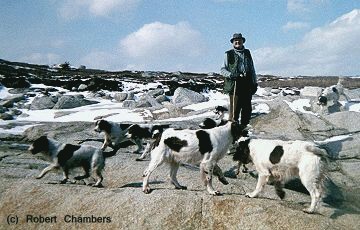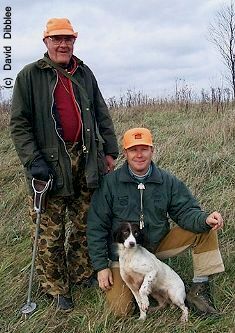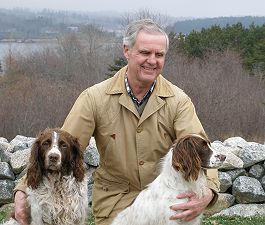 
David Graham McCurdy, M.D. has a host of friends and admirers on both side of the border. He is particularly renowned in Canada where he staged the first springer trial in the Atlantic provinces and founded the Scotia Springer Club. Over the decades, the beneficial effects of his selective breeding of field spaniels have rippled across the continent. Equally important, he has shared his success with others - helping countless people to enjoy the sport of field trialing.
At age ninety-one, Doc is a step slower than in his prime but heís still an imposing figure. He loves to chat about dogs, field trials and hunting. How much he hears in these conversations depends on the state of the battery in his hearing aid. Yet, even when he has to read your lips, heís genuinely interested in what you say and unfailingly courteous. The passage of time hasnít dimmed the twinkle in his eye, and his smile is as warm as ever.
David McCurdyís love for springers began seventy-five years ago, while he was in high school. Responding to a newspaper ad, he bought a two-year-old springer named Brier. The dog came with a lengthy pedigree, but was untrained. For a teenager without training experience, this could have presented a problem. On the positive side, Brier hadnít developed any bad habits. David recalls that after he and Brier established a bond, the dog more or less trained himself. In the process, the two had wonderful sport hunting snipe, grouse, woodcock and ducks - all within walking distance of Davidís home in Cape Breton.
This idyllic period ended when David left for university in Halifax to study medicine. Soon after qualifying as a doctor, the war broke out and he joined the Canadian Medical Corps. Following service overseas, he returned to Cape Breton with his wife Margot to practice medicine and establish a family.
"One reason for Docís success is that before training a pup - or a grown dog - he establishes a bond with it. This practice has resulted in many of his best hunting and trialing dogs also being house pets."
It wasnít until the early sixties that he had spare time to devote to field spaniels. In 1963, he imported his first Saighton dog from Talbot Radcliffeís kennel in Wales. Saightonís Sort was a 12-month-old male that so impressed Doc that he decided to start his own kennel. Docís hope was to breed the Saighton line in Canada. The stumbling block was Radcliffeís policy of withhold breeding rights when he sold a bitch. Doc, however, was able to persuade Talbot to let him have a bitch with the right to breed her. Thus in 1965, he was able to import Saightonís Samantha, a daughter of the famed British National Field Trial Champion, Saightonís Stinger, and littermate to Saighton's Signal, who, in 1971 went on to become a US National Amateur Field Champion.
Sort and Samantha became the foundation of Glenrock Kennels. Their first litter of eleven pups went, without exception, to hunters. One of the conditions of purchase was that the buyer must become a charter member of the yet-to-be-established Scotia Springer Club.
Glenrock Kennels was officially launched with the placement of the first Saighton litter. But this was just the beginning. All eleven pups (and most of their owners) would also have to be trained, and there was only one person qualified for the task - Doc. He was now well and truly into the spaniel game.
The Scotia Springer Club was incorporated on April 9, 1969. David G. McCurdy was the first to sign the charter and the clubís founding president. That same year, on the eighth of November, the club held the first licensed Open All Age trial in Atlantic Canada.
As Field Trial Secretary, Doc played a multi-faceted role in the event - providing ten of the eleven dogs (all from Sort and Samanthaís first litter). He selected the trial grounds, instructed the guns, obtained the birds, helped both human and canine participants, arranged for the judges and wrote up the results of the trial for the local newspaper.
The trial, held near Sambro outside of Halifax, was a great success. The entry fee was a modest fifteen dollars. The cover was good and the pheasants rocketed from the low shrubbery like wild birds. Doc won the trial with Saightonís Reamer. All agreed that Reamer deserved first place because, of the eleven entrants, he was the only dog that was steady. At the end of the day, all were invited back to Docís home in Halifax for a celebratory dinner prepared by Margot McCurdy.
Since then, Margot has become famous for her hospitality at field trials; especially for her cheese treats and seafood delicacies. Margot has also played the role of den mother to any number of stray children, neglected girlfriends and bored wives at these events.
"Not only does he always look at the bright side of things, but he encourages others to do so as well. At trials and training sessions he can be counted on to say something positive about every dog - even those that have few obvious qualities."
One reason for Docís success is that before training a pup - or a grown dog - he establishes a bond with it. This practice has resulted in many of his best hunting and trialing dogs also being house pets. His concern for the welfare of his dogs led to a screening policy to ensure that every Glenrock pup got a suitable owner. Doc could afford to be choosy as there were lots of hunters keen to buy his dogs. Some prospective buyers resented Docís probing questions; others became impatient at having to wait for him to make up his mind. Doc ignored the grumbling and stuck to his policy.
Jim Paul, after consulting with the Canadian Kennel Club field rep, approached Doc to buy a springer in 1974. Before he could buy a dog he had to join the Scotia Springer Club, attend its trials, read Talbot Radcliffeís book Spaniels for Sport and last but not least, wait a year. Jim, now a successful trainer and handler with a roomful of trophies and his own Novaway kennel, remains one of Docís staunchest admirers.
In 1977, the year Doc retired, the McCurdys were invited by Talbot Radcliffe to spend a two month "working holiday" at his estate on the Isle of Anglesey in Wales. They stayed at Presaddfed from the end of November to the end of January, the prime period for pheasant shooting in the British Isles. During driven shoots, Docís job was to beat with one of the Saighton dogs. Beating requires stamina and legs of steel as a lot of uneven ground must be covered. At the same time, the beaterís dog must be under perfect control. For Doc, who was a great hiker, skier and marathon walker, beating was merely a pleasant stroll with his dog. In the evenings, he and Margot mixed with the paying guests and assisted with the hospitality.
Just before the McCurdys returned to Canada, Talbot Radcliffe held an end of season "cocks only" shoot for a few friends and senior estate staff. Doc was one of the eight guns. By late January, the surviving cocks have been over the guns many times, and are quick to gain altitude as soon as they flush. High winds add to their speed, making them very hard to hit. British sportsmen often refer to these stratospheric birds as "archangels".
Doc shot brilliantly. At the end of the third drive, the head keeper approached Talbot to suggest discreetly that the Doctor withdraw from the line - he was killing so many cocks that if he continued, it might reduce the breeding stock! Talbot was most amused and told the story at dinner that evening.
In a similar vein, some years later Doc was shooting ducks on Talbotís estate with Bob Chambers, a friend from Halifax. The two men were in separate hides and fog made the shooting difficult. The ducks would suddenly appear out of the mist and disappear just as quickly. Because of the fog, Bob couldnít tell how Doc was making out until he heard a shot followed by a splash. The single shot accompanied by a splash was repeated many times throughout that morning.
Docís skill with a shotgun is not surprising, for heís had lots of practice on wild birds. An intrepid hunter, he has combed the length and breadth of Nova Scotia in search of game. At the end of the trialing season, he uses his spaniels to hunt grouse, woodcock and pheasant. On these rambles around the province, he has made many friends in the country who welcome his return each fall.
Except, of course, the lady who called the RCMP (Royal Canadian Mounted Police) when he dropped a fast flying rooster in her backyard. Doc protested that it was a perfectly safe shot, but his argument failed to impress the authorities. This incident cost him a fine and the loss of his hunting license for the rest of the year.
By the late eighties, Doc realized that his Glenrock kennel needed new blood. Once again, he went shopping in the British Isles. In the spring of 1992, he imported Birdrowe Fury of Webbswood, a ten-month-old male of the Rytex line. Fury came from impressive parents. His father was FTCH Rytex Rod and his mother, international FTCH Cresset Melody of Birdrowe - having won the Irish Spaniel Championship as well as achieving her British title.
When Fury arrived in Canada, Doc began his training from scratch - starting with a tennis ball. Even at this early stage, it was obvious that Fury had a good nose and a soft mouth and he enjoyed retrieving. He was also obedient. The only problem that Doc encountered in Furyís training was the dogís tendency to overshoot the mark on retrieves. As Fury matured, this fault disappeared.
By that time, however, he had been branded as a poor marker. When Fury went to Edmonton for the National in 1998, critics predicted he would be eliminated on the first retrieve. They were wrong. Fury won the 1998 Canadian National against the best dogs from both sides of the border, and the following year - when he was eight-and-a-half - he came second at the 1999 Canadian National in Sudbury, Ontario. Based on his Sudbury performance, many observers thought Fury should also have won in 1999.
"One of the most valuable lessons he learned from Doc was not to get upset when a training session goes awry."
Fury was handled in both nationals by John Mitchell, who has been a friend of Docís since the late seventies when he bought his first Glenrock dog. John was twenty at the time and had little interest in field trials. Like so many of Docís converts, he just wanted a hunting spaniel. After he bought the dog, Doc helped him to train it and later persuaded him to enter the dog in a trial. The rest is history.
As well as being one of the best trainers and handlers in Canada, John Mitchell owns Flushing Wing Kennels. One of the most valuable lessons he learned from Doc was not to get upset when a training session goes awry. Rather than trying to force the issue, John puts the dog back in its crate. By following this rule, he has found that training problems donít get out of proportion and can be dealt with calmly at the next session.
Bruce Outhouse is another of Docís customers who came for a hunting dog and became a field trialer. Now in his twelfth year as president of the Scotia Springer Club, he and his wife, Judy, own Longbrier Kennels. His conversion began after he bought a spaniel and went back to Doc for advice on how to teach it to heel. Doc took the dog for a few days and when Bruce returned, it was perfectly trained. Recalling the sequence of events, Bruce observed wistfully that it was the only dog heís ever had that heeled.
CNFC/FC Birdrowe Fury of Webbswood has proved to be a prepotent sire. For four consecutive years - 2000, 2001, 2002 and 2003 - Fury was Top Sire in Canada. In 2004, he was runner-up and so far in 2005 he is in second place.
One of Furyís sons, CNFC/CFC/AFC Gre-Sharís Cruise Control, won the Canadian National in 2001, handled by John Mitchell. And one of Furyís daughters, CFC Glenrock Rippyl, owned by Bruce Outhouse of Longbrier Kennels, was Canadian High Point Dam in 2004 and runner-up in 2003.
Until recently, Doc has enjoyed robust good health. However, in September 2001, a few weeks before his 88th birthday, he was rushed to the hospital with a life-threatening heart condition. The next morning he was wheeled into the operating room to have a pacemaker implanted in his chest. As the procedure was to be performed under a local anesthetic, the patient was fully conscious.
Just before the surgeon made his incision, Doc realized where the device was going and cried: "Stop! You canít put that on my left side. Thatís the shoulder I shoot from!"
His outburst was greeted by a shocked silence. Then everyone in the operating room broke into laughter. The surgeon accommodated Docís wish by inserting the pacemaker on his right side. Before nightfall, the story of the drama in the operating room was known all over the hospital.
The following Saturday Doc rose in the dark, tiptoed out of the house, loaded his dog into the car and drove to the Scotia Springer Clubís fall trial. Surprise turned to dismay in the gallery when Doc walked to the line with Kay (Flushing Wing Ka Kickity Katie) for the first series. John Mitchell had offered to run her, but Doc was determined to do it himself.
Sloping ground, no breakfast, and the long drive all combined to drain Docís strength. After the first bird, it was suggested that he rest and come back for the second series. Doc wouldnít hear of it. Then Kay got on the trail of a running cock. Doc wasnít able to keep up with her and the pheasant flushed out of range. A lucky pellet winged the bird, which landed at the edge of the forest and disappeared. The gallery hoped it would be declared a "no bird" but the judge tapped Doc and off went Kay. Near the spot where the pheasant had landed, the dog entered the woods.
The minutes ticked by while Doc waited in the hot sun, propped up by a shooting stick. Eventually, far down the course, Kay emerged from the trees with the rooster in her mouth. A flawless delivery to her master topped off this memorable performance. Somehow, Doc managed to get through the rest of the day, which included an excruciating third series where the guns tried too hard and failed to provide a retrieve for Kay.
A friend drove Doc home that evening, but he was back again the next morning. On the second day of the trial, it rained buckets and many people left before it was over. Doc stuck it out to the end and Kay earned a placement.
Docís positive mental attitude undoubtedly helped him get through the trial. Not only does he always look at the bright side of things, but he encourages others to do so as well. At trials and training sessions he can be counted on to say something positive about every dog - even those that have few obvious qualities.
For example, if a dog ignores the whistle and runs amok at a trial, the gallery will usually remain silent and avert their eyes when the handler leaves the field. Doc, knowing how miserable the person feels, will put a positive spin on the disaster, cheerfully hailing the unfortunate handler with: "Even the best dogs break occasionally." Should this old chestnut be greeted with silence, Doc might add: "Your dog must be in wonderful condition to cover so much ground, so quickly." Still no answer: "Heís also got a great nose, it was amazing how he found all those birds - and on both sides of the line!"
If an owner is inconsolable, Doc will pay his compliment of last resort. Itís an oldie but a goody. Staring at the unhappy personís dog as though noticing it for the first time, he will say in a surprised voice: "Your dog has fine brown eyes!" (pause) "Iíve always liked a dog with dark brown eyes." (pause) "Talbot did too - said it showed loyalty, intelligence and trainability."
Even the most discouraged novice will perk up at this news. After checking that his spaniel has brown eyes, he will lead it away with hope in his breast, feeling better for having spoken to Doc. As so many have before him. 
|
|
|
| Bookstore | The Bookshelf | Advertise on SJ | Classifieds | Resources | Events | NEW! Point Standings | Letters | Archives | Spaniel Journal | |



